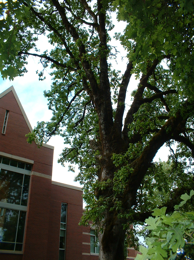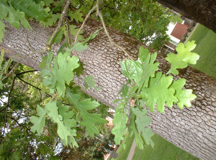The Oregon White Oak
Tag Number: 374-377
 |
 |
 |
 |
 |
Scientific Name: Quercus garryana
Prunus means plum, and subhirtella means somewhat hairy, as are the bottom of the Weeping Cherry's leaves.
Common Names
- Garry Oak
- Oregon White Oak
- Pacific Post Oak
- Western White Oak
Habitat
Grows naturally in British Columbia and on the coastline of Washington, Oregon, and California. It is the only native oak north of Eugene, Oregon. Often used as a decorative tree by landscapers and at homes and parks for shading.
Morphology
The caps on the acorns are shallow. Unlike the two other species of oak that grow naturally in the northwest, the leaves of the Oregon White Oak have seven to nine round lobes. Landscapers give many reasons for using this tree in their artwork, and everyone agrees it has a striking shape. However, many feel that the tree's greatest quality is in the misty-white tone of the bark.
Phenology
Flowers appear at the same time as the leaves. Female flowers are usually found singly; males are more obvious, since they hang downward in a cluster called a catkin.
History
Fun-seekers enjoy jumping on the fallen leaves of this tree to hear the popping noise of the galls that lie underneath. Although the galls are nurseries for wasp larvae, the wasps do not harm humans. The galls are produced by the oak leaf in response to having the wasp's eggs laid inside of it. Another benefit of this tree, certainly more practical, is due to the protein content of the leaves, which equals that of alfalfa. Thus the leaves are eaten by livestock and deer. Further, when heavy snow threatened Willamette Valley livestocks' lives in 1880, settlers saved several of their animals by feeding them the bark from the tree. Two oak trees stand outside of Abbott Alumni House, dedicated to those responsible for its construction: former Pacific University presidents Faith Gabelnick and Phil Creighton.
Ethnobotany
Many who have tasted the acorns of this oak claim that they are ghastly; however the Salish, of Washington's Puget Sound region, harvested and buried the nuts near streambeds. There, the water washed over them and removed the tannin compounds that made them taste bitter. The Saanich fought tuberculosis by administering the bark of the Oregon White Oak with that of 3 other trees. Although the Oregon White Oak is neither threatened nor endangered, its numbers have decreased dramatically. Before fire laws were set in place, Native Americans burnt conifer forests to the ground, which allowed the oaks to grow and helped the animals they hunted get proper nutrition.


